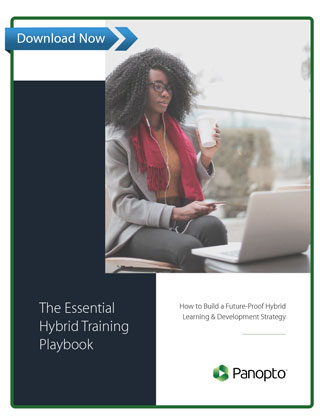- Remote Work
Training a Hybrid Workforce? Avoid These 5 Mistakes

Are you ready for hybrid training? With 73% of businesses in the U.S. and 65% of those in Europe adopting a hybrid working model for the foreseeable future, chances are you’re already a hybrid learning organization.
As companies tentatively return to physical offices or field work, learning and development (L&D) leaders are now responsible for delivering flexible and effective programs to both remote and in-person employees – all in the face of changing workplace expectations and fragmented digital tools that create inefficiencies impacting engagement, time, and budget.
With so many responsibilities in an evolving business environment, it’s easy for training managers to overlook key issues when developing a hybrid training strategy.
Let’s explore five common hybrid training mistakes – and how you can avoid them.
Defining hybrid training vs. blended training
What’s the difference between hybrid training and blended training?
Hybrid learning (or hybrid training) is an educational approach that allows learners to engage via in-person classroom experiences, digital learning methods, or both. Learners have the choice of how and when to engage with the material.
Blended learning (or blended training) is an approach where courses are delivered via set online and in-person components. With blended learning, every learner experiences the same mix of digital and face-to-face learning.
Video is the backbone of both hybrid and blended learning. Training programs supported by video give learners choice and flexibility in engaging with material – the key principles of a successful hybrid training approach.
5 common hybrid training mistakes
Mistake 1: Not recording your training
Imagine if every email you sent disappeared immediately after it was read – it’s unthinkable. Yet many L&D leaders take the same approach to training by failing to record their courses.
As your training programs evolve to encompass both in-person and virtual components, recording your training is essential to a hybrid L&D strategy that is flexible, accessible, and effective for all employees.
Why record?
- Boost engagement by providing more flexible training schedules where learners have the choice of how and when to take part
- Improve accessibility by supporting employees that learn at different paces, allowing them to review material as needed
- Increase productivity with a library of on-demand knowledge for easy reference
With so many digital tools at our disposal, it’s easier than ever to capture lectures, demonstrations, role-play exercises, and any number of training experiences your employees need to succeed. If there’s one thing to take away from this article: record your training.
Mistake 2: Taking a one-size-fits-all approach to training
The pandemic forced many L&D teams to pivot to remote practices almost overnight, standing up whichever tools and processes could sustain training programs as quickly as possible.
It’s no longer enough to merely sustain your L&D efforts. A successful hybrid training strategy must be purpose-built to meet the unique needs of your curriculum and employees, building on the processes that have been working and evolving those that haven’t.
Rather than taking a reactive, blanket approach to training, tailor your tools and communication process to suit the different types of training you deliver. For example, an HR compliance training might be most effective with an asynchronous, remote model, where a hands-on technical course would require synchronous, in-person demonstration alongside a pre-read on theory.
A proactive approach to hybrid training helps:
- Increase engagement and improve training consistency among in-person and remote learners
- Support more flexible and accessible learning by giving employees control over their training experience
- Reduce costs and shorten training schedules by optimizing synchronous classroom time
- Enable training programs to scale by establishing an on-demand video resource library
Mistake 3: Juggling multiple tools to manage training recordings
Trainers and L&D leaders have enough on their plate without the added task of juggling tools to save, edit, upload, and share training materials and recordings. As your library of digital and video training content grows, so too do concerns around storage bandwidth and security. It’s easy to forget to save a recording, upload it to the wrong folder, or set inaccurate sharing permissions, resulting in lost content or security vulnerabilities.
Integrate and streamline your hybrid training tech stack with a single comprehensive tool, such as an enterprise video content management system (VCMS). Securing your training recordings in a VCMS that integrates with your existing tools like an LMS, CRM, or video conferencing platform creates a more seamless experience for both trainers creating content and employees engaging with it.
Free up your trainers to focus on what they do best: inspiring, educating, and improving employee performance.
Mistake 4: Neglecting on-demand training content
Training doesn’t stop at the end of a course. Research shows that just 30 minutes after a learning session, staff remember only 58% of the material covered, a figure that drops to 35% after one week. Yet more often than not, training videos are saved in a folder never again to see the light of day – that is, if they’re recorded at all.
You already know how important it is to capture your training. With your hybrid workforce more distributed than ever, it’s essential to provide consistent, searchable, on-demand access to past training recordings – whether it’s helping employees in the field access knowledge needed to complete an installation, or enabling remote workers to reference social learning modules from a recently offboarded colleague.
Easily discoverable, on-demand training resources allow employees to access critical knowledge “at the speed of need,” improving engagement, productivity, and strengthening learning outcomes.
Mistake 5: Insisting on perfectly polished training videos
Think back to the most valuable training you’ve received – was it a sleek corporate training film or a DIY YouTube video?
Quality is key to successful training, but authentic, personal knowledge sharing is often more powerful than a highly produced – and expensive – training video. By lowering the barriers to knowledge exchange, training managers can build a culture of continuous learning that improves engagement and productivity.
Your trainers are already seasoned content creators. Leverage their skills for a hybrid training context and empower trainers and employees to easily record, edit and share video training, such as:
- Long-form lectures for a flipped training
- Informal peer-to-peer or social learning videos
- Short-form, digestible microlearning units
- Onboarding and offboarding videos
What does hybrid training mean for my organization?
While there’s no single approach to a hybrid training model, prioritizing consistency, flexibility, and choice will set your L&D programs up for success. These five strategies are a great start to helping you define and develop a robust hybrid training strategy for your organization.
- Record your training
- Develop a proactive hybrid training approach based on learner needs
- Consolidate your hybrid training tech stack with a VCMS
- Establish on-demand access to training
- Empower trainers to be video content creators
Download The Essential Hybrid Training Playbook

Whether you’re new to hybrid learning or ready to scale your existing hybrid training programs, we developed The Essential Hybrid Training Playbook as your actionable guide to creating a future-proof hybrid L&D strategy.
Download The Essential Hybrid Training Playbook to discover:
- 6 steps to building a future-proof hybrid training strategy
- Best practices for building a corporate video learning library
- An actionable checklist to strengthen training initiatives
- Case examples and lessons learned from L&D leaders



